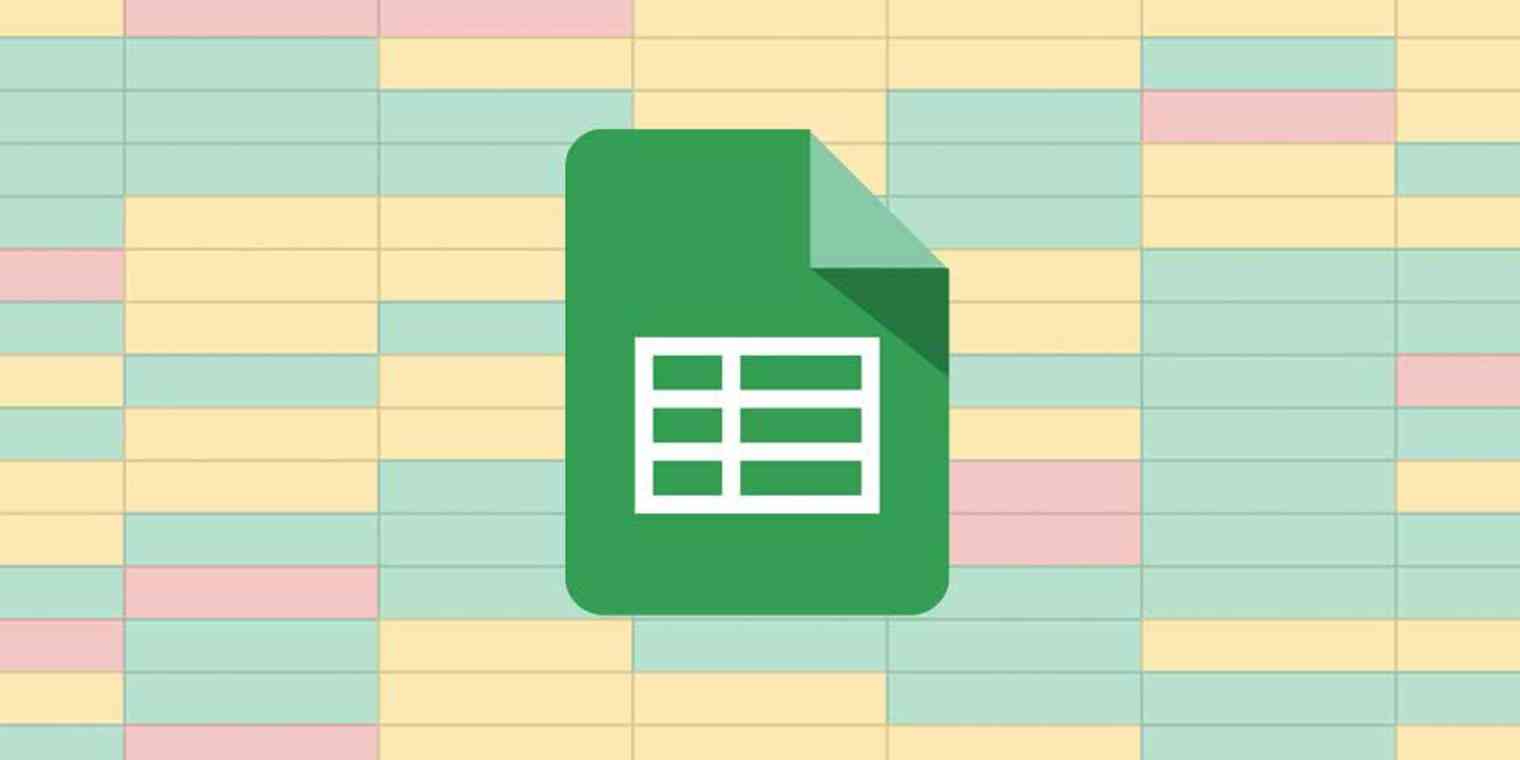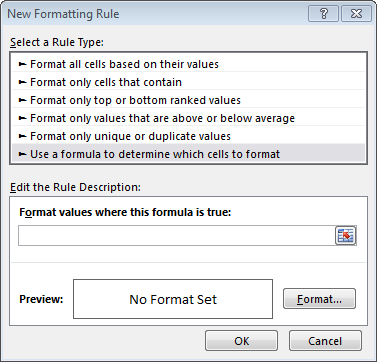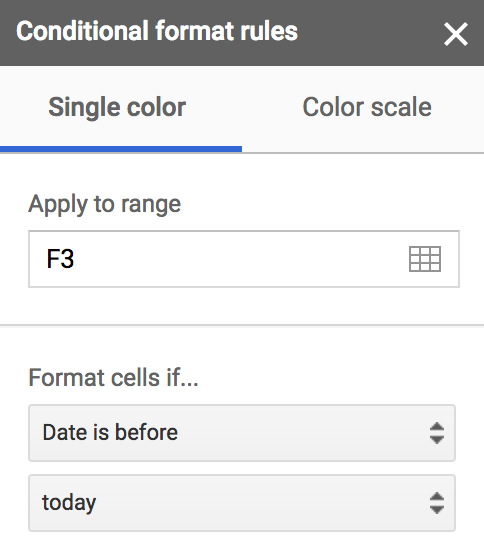If you have Microsoft Word, you can use it to add conditional statements to templates. You can use other programs to create templates, but Word has tools that will make the process a little easier. Conditional statements are case and space sensitive. To apply conditional formatting, select a Table or Matrix visualization in Power BI Desktop. In the Visualizations pane, right-click or select the down-arrow next to the field in the Values well that you want to format. Select Conditional formatting, and then select the type of formatting to apply.
Where is Conditional Formatting in Microsoft Excel 2007, 2010, 2013, 2016, 2019 and 365
How to Bring Back Classic Menus and Toolbars to Office 2007, 2010, 2013, 2016, 2019 and 365? |
Used way to get Conditional Formatting if you are using Classic Menu for Office
Classic Menu for Office will bring you back to the familiar interface of Microsoft Excel 2003/XP(2002)/2000. Just click the “Format” item on the mail menu, you will find the “Conditional Formatting” item staying in the list.
Conditional Formatting in Microsoft Excel 2007/2010/2013/2016/2019 Ribbon
If you do not have Classic Menu for Office, and have never used Microsoft Excel 2007/2010/2013/2016/2019 Ribbon before, it may be a little difficult to find out the “Conditional Formatting” button quickly in the completely new Ribbon at the beginning.
However, it is also very convenient to get this button after you are used to Microsoft Excel 2007/2010/2013/2016/2019 Ribbon. Launch Microsoft Exce, click the “Home” tab, and go to the “Styles” group, then you will see the “Conditional Formatting” button there:

It seems somewhat hard to get used to the new ribbon in a short time. Please do not worry about it! Classic Menu for Office brings back used classic styles interface of Microsoft Office 2003 with all new feature of Microsoft Office 2007, 2010, 2013, 2016, 2019 and 365. Classic Menu for Office is an excellent helper to easy your learning curve.
More Related Articles...
Classic Menu for Office
Brings the familiar classic menus and toolbars back to Microsoft Office 2007, 2010, 2013, 2016, 2019 and 365. You can use Office 2007/2010/2013/2016 immediately without any training. Supports all languages, and all new commands of 2007, 2010, 2013, 2016, 2019 and 365 have been added into the classic interface.
Classic Menu for OfficeIt includes Classic Menu for Word, Excel, PowerPoint, OneNote, Outlook, Publisher, Access, InfoPath, Visio and Project 2010, 2013, 2016, 2019 and 365. |
Classic Menu for Office 2007It includes Classic Menu for Word, Excel, PowerPoint, Access and Outlook 2007. |
Screen Shot of Classic Menu for Excel
INTRODUCTION
Whenever we prepare any report in excel, we have two constituents in any report.
The Text portion and the Numerical portion.
But just storing the text and numbers doesn’t make the super reports. Many times we need to automate the process in the reports to minimize the effort and improve the accuracy.
Many functions are provided by the Excel which work on Text and give us the useful output as well. But few problems are still left on which we need to apply some tricks with the available tools.
THIS WAS AN EXCERPT FROM THE FIRST ARTICLE OF THIS SERIES MANIPULATING TEXT IN EXCEL – PART I
In this articles , we will continue learning many more techniques about the manipulation of text in Excel.
HOW TEXT IS HANDLED IN EXCEL?
TEXT is simply the group of characters and strings of characters which convey the information about the different data and numbers in Excel. Every character is connected with a code [ANSI].
Text comprises of the individual entity character which is the smallest bit which would be found in Excel.
We can perform the operations on the strings[Text] or the characters.Characters are not limited to A to Z or a to z but many symbols are also included in this which we would see in the later part of the article.
TEXT IS AN INACTIVE NUMBER TYPE[FORMAT] IN EXCEL. ANYTHING STORED AS TEXT [NUMBER OR DATE] WON’T RESPOND TO ANY STANDARD FORMULAS OR FUNCTIONS BUT SPECIALLY DESIGNED TEXT FUNCTIONS. [EXCEPTIONS DO OCCUR IN CASE OF NUMBERS]
If we need to make anything inactive, such as Date to be non responding to the calculation, we put it as a text. Similarly if we want to avoid any calculations for a number it needs to be put as a text.
CONDITIONAL FORMATTING BASED ON TEXT
CONDITIONAL FORMATTING is the process of formatting in Excel on the basis of the conditions. We can put many conditions in the cell and program the Excel to make the formatting , as desired, if the particular condition is met. Formatting comprises of the foreground color, background color, font, size etc. which are the properties of the text.
It makes the results more readable.
IT IS RECOMMENDED TO LEARN THE BASICS ABOUT CONDITIONAL FORMATTING, IF NOT VERY COMFORTABLE WITH THIS TOPIC.
CLICK HERE TO LEARN ABOUT CONDITIONAL FORMATTING.
Maximum times, we apply the conditional formatting on the basis of values present in the cells. Let us now learn the way by which we can apply the conditional formatting using the Text.

HIGHLIGHTING THE TEXT EQUAL TO SOME VALUE:
Let us find out the cell which contains a text value equal to some SPECIFIED TEXT.
For the example let us take this block of text values in Excel.
Let us try to highlight the cells containing HELLO.
It can be done in two ways.
1. Using the predefined options.
2. Using custom formula.
STEPS to highlight cells using the predefined option:
- Select the complete table.
- Go to HOME TAB>CONDITIONAL FORMATTING>HIGHLIGHT CELL RULES>EQUAL TO
- Click EQUAL TO.
- Following dialog box will open.
- Enter the value in the field as shown in the picture.
- Select the format of the cells which satisfy the condition.
- and Click OK.
- After clicking OK, we will see the result as the cell with HELLO will be in pink. [The option doesn’t differ the cases. Both of upper and lower cases will be taken as same.]
- Similarly we can find other values too.
2. Using custom formula.
STEPS to highlight cells using the custom formula:
- Select the complete table.
- Go to HOME TAB>CONDITIONAL FORMATTING>NEW RULE.
- A dialog box as shown in the picture below will open.
- Click the last option: use a formula to determine which cells to format.
- Enter the formula in the field as =E6=”HELLO”.
- Set the format as per your choice. We set the fill color as green.[Don’t forget to change the format otherwise difference won’t be visible.]
- Click OK.
- The result will be highlighted as shown in the picture below.

For the concept OF CONDITIONAL FORMATTING CLICK HERE.
EXAMPLE 2:STEPS TO HIGHLIGHT THE TEXT MATCHING THE GIVEN TEXT [EXACT MATCH]
In this example, let us find out the way to highlight the cells which contains the text same as some specified text exactly with the same content and with the same case. GENERALIZED FORMULA TO HIGHLIGHT THE EXACT TEXT:=EXACT(FIRST CELL OF SELECTION, “TEXT TO BE MATCHED”).For our example, we will highlight the cell containing the text “Yellow”. Follow the steps.
- Select the complete table.
- Go to HOME TAB>CONDITIONAL FORMATTING>NEW RULE.
- A dialog box as shown in the picture below will open.
- Click the last option: use a formula to determine which cells to format.
- Enter the formula =EXACT(E6,”Yellow”).
- Choose the format of your choice, which will appear when some cell fulfill the condition.
- Click OK.
For the concept OF CONDITIONAL FORMATTING CLICK HERE.
EXAMPLE 3: STEPS TO HIGHLIGHT THE CELLS IF TEXT CONTAIN A SPECIFIC CHARACTER
Suppose we want to create a condition when we want to highlight the cell if the cell contains any specific character say # for our example.GENERALIZED FORMULA TO HIGHLIGHT THE CELLS WHICH CONTAIN A SPECIFIC CHARACTER
- Select the complete table.
- Go to HOME TAB>CONDITIONAL FORMATTING>NEW RULE.
- A dialog box as shown in the picture below will open.
- Click the last option: use a formula to determine which cells to format.
UPDATE 1

For the concept of CONDITIONAL FORMATTING CLICK HERE.
EXAMPLE 4: HIGHLIGHT THE TYPE OF OBJECT AS SELECTED FROM A DROPDOWN LIST
This situation can come across frequently when we need to highlight some specific category of items or objects. NOTE: ONE POINT HERE IS WORTH MENTIONING THAT WE MAKE USE OF CONDITIONAL FORMATTING MOSTLY WHEN OUR DATA IS MIXED. IF THE DATA IS ALREADY ORGANIZED WHY WOULD WE NEED TO HIGHLIGHT IT. Let us try to create a list where we can highlight the countries lying in a particular continent by selecting the continent from a drop down list.Something like, shown in the picture below.
SOLUTION:
This problem comprises of different steps for the solution. Here is the list.
Conditional Formatting In Word 2010
1. Creating a dropdown with continent names as the dropdown options.
2. Setting the CONDITIONAL FORMATTING rule for the given data to highlight the cells containing the countries of the selected continent.
3. Setting the format for the highlighted cells.
STEP 1:
CREATING A DROPDOWN LIST FOR CONTINENTS LIST
Follow the steps to create a dropdown list.
[ THE COMPLETE DETAILS OF CREATING A DROPDOWN ARE HERE ]
- Create a simple list of the continents which will be used as the source for the dropdown.
- The list can be on the same sheet or other sheet as per the convenience.
- Create a LABEL as SELECT THE CONTINENT .
- Next to the LABEL select the cell, where we’ll populate our dropdown list.
- Go to DATA TAB > DATA VALIDATION DROPDOWN > DATA VALIDATION
- A dialog box will open as shown below.
- Select LIST from the ALLOW DROP DOWN as shown in the first picture.
- After choosing the LIST OPTION , select the source as the range containing the continents. We can directly enter the range or can choose it using the mouse.
- After choosing the source, we can directly click OK to close the dialog box or we can choose the tab INPUT MESSAGE and choose the INPUT MESSAGE as SELECT THE CONTINENT TO HIGHLIGHT THE COUTRIES as shown in the last picture.
- Click OK.
After clicking OK, the dropdown list has been inserted in the cell.
STEP 2: CREATING CONDITIONAL FORMATTING RULES TO HIGHLIGHT THE COUNTRIES OF THE SELECTED CONTINENT
FOLLOW THE STEPS TO ADD CONDITIONAL FORMATTING RULES
- Select the data excluding the headers.
- Go to HOME TAB > CONDITIONAL FORMATTING DROP DOWN > NEW RULE.
- As we click NEW FORMATTING RULE , the dialog box will open.
- Choose the last option – USE A FORMULA TO DETERMINE WHICH CELLS TO FORMAT.
- Enter the formula as =$D$5=$F6. [D5 contains our selected continent and F6 is the first cell of the selection. $ has been applied to make the reference absolute for the selection as we don’t want to the selection to go relative whereas the F6, we want the column to be fixed so apply $ before F. [ Learn Conditional Formatting for details ]
- After entering the formula, click FORMAT BUTTON as shown in the picture below.
- As we click the format button, a FORMAT CELLS DIALOG BOX opens up.
- Choose the format as per your choice.
- We went for FILL TAB > FILL EFFECTS > AND CHOSE AN EFFECT AS SHOWN IN THE PICTURE BELOW.
- You can choose the format of your own. This format will be visible in all the cells which satisfy our rule we entered.
- Click OK.
- We are done.
CHECKING THE OUTPUT:
We can check the example by selecting the continent from the dropdown.
Conditional Formatting In Word
ONE MORE EXAMPLE FOR CONTROLLING THE CONDITIONAL FORMATTING WITH THE TEXT OR NUMBERS AT OTHER POSITION IS HERE.

CREATING A SIMPLE GANTT CHART IN GOOGLE SHEETS
ALTHOUGH, THE ARTICLE SHOWS THE USAGE OF CONDITIONAL FORMATTING IN GOOGLE SHEETS, BUT IT IS COMPLETELY UNDERSTANDABLE AND WORTH READING. TAKE A LOOK AT MORE EXCEL TRICKS. YOU MAY FIND SOMETHING INTERESTING.
EXCEL TRICKS EXPLAINED
THERE’S ALWAYS ROOM FOR IMPROVEMENT.
KINDLY GIVE YOUR VALUABLE SUGGESTIONS.